Kohima district
Kohima District (/koʊˈhiːmə/ ⓘ) is a district of the Indian state of Nagaland. It is the home of the Angami Nagas. As of 2011, it is the most populous district of Nagaland (out of then-12, now 16), with a population of 267,988, 45% of which is urban. The district is home to 13.55% of Nagaland's entire population.[3] The administrative headquarters of the district is located at Kohima, the capital city of Nagaland. Kohima District is also the seventh-largest district in Nagaland with an area of 1,207 square kilometres (466 sq mi).[3]
Kohima District | |
|---|---|
 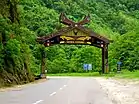 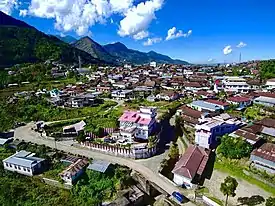  From Top (left to right): Kohima City (the headquarters of Kohima District); Road to Kohima; Viswema; Dzüko Valley | |
| Nickname: First District | |
.svg.png.webp) Kohima District in Nagaland | |
| Country | |
| State | Nagaland |
| Headquarters | Kohima |
| Government | |
| • Lok Sabha Constituency | Nagaland |
| • MP[1] | Tokheho Yepthomi, NDPP |
| • Assembly constituencies | 7 constituencies |
| • Deputy Commissioner[2] | Shanavas C, (IAS) |
| Area | |
| • Total | 1,207 km2 (466 sq mi) |
| Elevation | 1,444 m (4,738 ft) |
| Population (2011[3]) | |
| • Total | 267,988 |
| • Density | 220/km2 (580/sq mi) |
| Demographics | |
| • Literacy[3] | 85.23% |
| • Sex ratio[3] | 928 ♀/ 1000 ♂ |
| Languages | |
| • Official | English |
| • Indigenous dialect[4] | Angami |
| Time zone | UTC+05:30 (IST) |
| ISO 3166 code | IN-NL-KO |
| Major highways | |
| Website | kohima |
History
Prior to India's independence, the area was part of Naga Hills District, with Kohima as the district headquarters.[5]
Kohima District was created as one of the three districts of the newly inaugurated of Nagaland state on 1 December 1961.[3] In 1973, the new districts of Phek and Wokha were created out of Kohima District, as in 1997 Dimapur District was similarly carved out.[6][7] Peren District was carved out in 2003.[8] The 2021 creation of Tseminyü District left Kohima District in its current form.
Geography
Kohima District has a hilly landscape - Kohima Urban Area, typical of the area, is stretched along the top of a mountain.[3] The district is bounded by Tseminyü District to the north, Zünheboto District to the northeast, Phek District to the east, Senapati District of Manipur to the south, Peren to southwest and Chümoukedima District to the west. It is headquartered at Kohima, which is at an altitude of 1,444 metres (4,738 ft) above sea level. Mount Japfü at elevation of 3,014 metres (9,888 ft), the highest peak in the district is located in the Southern Angami Region of the district.[9]
Flora and fauna
In 1980, Kohima District became home to the Pulie Badze Wildlife Sanctuary, which has an area of 9.2 km2 (3.6 sq mi).[10] It is a natural habitat for Blyth’s Tragopan.[11]
Climate
| Climate data for Kohima | |||||||||||||
|---|---|---|---|---|---|---|---|---|---|---|---|---|---|
| Month | Jan | Feb | Mar | Apr | May | Jun | Jul | Aug | Sep | Oct | Nov | Dec | Year |
| Average high °C (°F) | 16.6 (61.9) |
17.9 (64.2) |
22.1 (71.8) |
24.1 (75.4) |
24.4 (75.9) |
24.9 (76.8) |
25.0 (77.0) |
25.4 (77.7) |
25.0 (77.0) |
23.4 (74.1) |
20.6 (69.1) |
17.7 (63.9) |
22.2 (72.0) |
| Average low °C (°F) | 8.1 (46.6) |
9.3 (48.7) |
12.7 (54.9) |
15.6 (60.1) |
16.9 (62.4) |
18.1 (64.6) |
18.8 (65.8) |
18.9 (66.0) |
18.1 (64.6) |
16.6 (61.9) |
13.1 (55.6) |
9.4 (48.9) |
14.6 (58.3) |
| Average rainfall mm (inches) | 11.7 (0.46) |
35.4 (1.39) |
47.6 (1.87) |
88.7 (3.49) |
159.2 (6.27) |
333.8 (13.14) |
371.8 (14.64) |
364.0 (14.33) |
250.1 (9.85) |
126.0 (4.96) |
35.2 (1.39) |
7.8 (0.31) |
1,831.3 (72.1) |
| Average rainy days | 2 | 3.9 | 5.8 | 12.2 | 16.9 | 23.1 | 24.6 | 22.9 | 19.1 | 10.7 | 3.6 | 1.4 | 146.2 |
| Source: WMO [12] | |||||||||||||
Administration
Kohima District is administered by a Deputy Commissioner, who has a number of Additional Deputy Commissioners (ADCs) and Sub-Division officers (SDOs) with responsibilities for each of the administrative circles.[13] There exists also a District Urban Development Agency for Kohima.[14] The current Deputy Commissioner of Kohima District is Shanavas C.[2]
Kohima District is subdivided into the five administrative circles of Chiephobozou, Botsa, Kezocha, Jakhama, Kohima Sadar and Sechü–Zubza. These administrative circles are grouped into three Rural Development Blocks, which are Kohima (for Kohima Sadar and Sechü–Zubza), Chiephobozou (for Chiephobozou, Botsa and some of Kezocha) and Jakhama (for Jakhama and the rest of Kezocha).[3]
Urban and rural centres
Kohima Sadar circle comprises two towns:
- Kohima (99,039), Kohima Village (15,734), and the two villages of Chiedema (1,820), Chiede Model Village (277).
Jakhama circle comprises ten towns and villages:
- Viswema (7,417), Jakhama HQ (5,216), Khuzama (5,160), Jakhama Village (4,695), Kigwema (3,872), Phesama (3,061), Mima (2,149), Kigwe Town (1,228), Pfuchama (870), Swe–ba (388).
Chiephobozou circle comprises eighteen villages:
- Zhadima (3,184), Chiechama (3,172), Rüsoma (1,903), Chiephobozou (1,841), Nerhema (1,678), Tsiese Basa (1,563), 4th NAP Battalion Thizama (1,505), Meriema (1,233), Thizama (803), Tsiese Bawe (620), Viphoma (456), Nachama (422), Phekerkrie Bawe (301), Nerhe Model (301), Phezha (285), Ziezou (245), Phekerkrie Basa (147), Viphoma Basa (33).
Sechü–Zubza circle comprises sixteen villages:
- Sechü Zubza (4,460), Jotsoma (2,458), Phezhu (2,391), Mezoma (2,177), Khonoma (1,943), Peducha (1,087), Mengujuma (537), Kiruphema Basa (462), Sechüma (419), Thekrejüma (316), Sirhi Angami (286), Mezo Basa (285), Kiruphema Bawe (237), Dzuleke (156), Khonoma Basa (96), Hydro Project Station (59).
Kezocha circle comprises ten villages:
- Kidima (7,160), Sakhabama (2,857), Kezoma (2,117), Dihoma (1,550), Kezo Town (1,122), Kijümetouma (638), Kezo Basa (490), Mitelephe (245), Kijümetou Basa (149), Kezocha Hq (139).
Botsa circle comprises ten villages:
- Tuophema (2,236), Botsa (1,063), Gareiphema (952), Seiyhama (903), Teichüma (610), Tsiemekhuma Bawe (288), Tsiemekhuma Basa (283), Tuophe Phezou (132), Gareiphe Basa (122), Seiyha Phesa (106).
Demographics
| Year | Pop. | ±% |
|---|---|---|
| 1901 | 21,968 | — |
| 1911 | 32,750 | +49.1% |
| 1921 | 33,797 | +3.2% |
| 1931 | 37,785 | +11.8% |
| 1941 | 37,601 | −0.5% |
| 1951 | 37,339 | −0.7% |
| 1961 | 41,501 | +11.1% |
| 1971 | 63,077 | +52.0% |
| 1981 | 97,169 | +54.0% |
| 1991 | 154,145 | +58.6% |
| 2001 | 220,168 | +42.8% |
| 2011 | 267,988 | +21.7% |
| Source: [15] | ||
According to the 2011 census of India Kohima District has a population of 267,988, of which 121,088 or 45% lived in urban areas. This gives it a ranking of 576th in India (out of a total of 640). Kohima district has a sex ratio of 928 females for every 1000 males, and a literacy rate of 85%.[3]
The main indigenous inhabitants of Kohima District are the Angami Nagas.
Religion
Religion in Kohima District (2011)[16][lower-alpha 1]
Christianity is the largest religion in the district, followed by 85% of the people. Hinduism is the second-largest religion, followed by 11% of the population. Islam and Other religions form 1.8% and 0.57% of the population respectively.[16]
Languages
The following languages are spoken in Kohima District:[4]
Government and politics
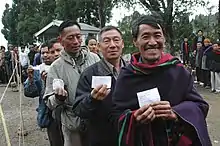
The district has seven assembly constituences, namely, Kohima Town, Northern Angami I, Northern Angami II, Southern Angami I, Southern Angami II and Western Angami. The last elections were held in 2023. The next legislative assembly election will be held in 2028.
As part of the Lok Sabha, Kohima District is part of the Nagaland Lok Sabha constituency. In the 2019 Indian general election, Tokheho Yepthomi of the NDPP won by 16,000 votes over his rival K.L. Chishi of the Indian National Congress.[1] The next general election is in 2024.
Economy
Agriculture
Agriculture forms the major economic activity in the district. Most of the agriculturists in the district practice Shifting cultivation or Jhum cultivation. The main crop in the district is Paddy. Maize is another cereal produced in the district. Other major crops grown in the district are Potatoes, Ginger, Soybean and Ricebean.[9] Among vegetables and fruits, Pineapples, Oranges, Cabbages, Tomatoes, Papayas, etc. are grown throughout the district.
Animal husbandry
Animal husbandry acts as a supplementary income for the people in Kohima district. The sector also provides employment to small and marginal farmers. As per the Livestock Census in 2007, the most prevalent type of livestock in the district are Fowls, Cattles and Pigs.[9]
Industry
There are no large industries in the district. However, there are numerous Small and medium-sized enterprises. The number of MSMEs registered in the district till 2009-10 numbered to 52 which employed around 571 persons. The Angami Nagas in the district are skilled artisans and craftsmen.[9]
Education
As per the 2011 Census of India, Kohima District as a literacy rate of 85.23%.[3] Literacy among the Scheduled Tribes stands at 83.86% with male literacy at 79.6% and female literacy at 88.45%.[3] There are numerous colleges in the district.[18]
Colleges
- Alder College, Kohima
- Baptist College, Kohima
- Capital College of Higher Education, Kohima
- College of Arts and Technology, Nerhe–Phezha
- Faith Theological Seminary, Kohima
- Japfü Christian College, Kigwema
- Kohima Bible College, Kohima
- Kohima College, Kohima
- Kohima Law College, Kohima
- Kohima Science College, Jotsoma
- Kros College, Kohima
- Model Christian College, Kohima
- Modern College
- Modern Institute of Teacher Education, Kohima
- Mount Olive College, Kohima
- Mountain View Christian College, Kohima
- National Institute of Electronics & Information Technology (NIELIT), Kohima
- Oriental College, Kohima
- Sazolie College, Jotsoma
- Shalom Bible Seminary, Sechü Zubza
- St. Joseph's College, Jakhama
- State College of Teacher Education, Kohima
Universities
- Indira Gandhi National Open University (IGNOU) Regional Centre, Kohima
- Nagaland University, Meriema Campus
- The Global Open University, Kohima
Sports
Football
Kohima District is home to Kohima Komets, a professional football club that plays in the Nagaland Premier League. The Indira Gandhi Stadium, Kohima is a multipurpose stadium mainly used for football. It has an artificial turf.
Tourism
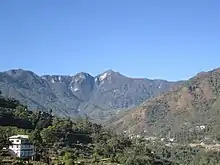
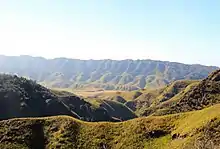

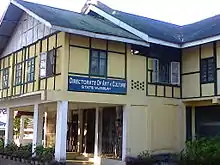
Kohima District has various tourist places to visit. Below are few of the tourist attractions in the district:[9][20]
Dzüko Valley
The Dzüko Valley is situated 25 kilometres south of Kohima at an altitude of 2,462 metres (8,077 ft). Between November and March, the valley is dotted with red and white rhododendrons and wildflowers.[9]
Khonoma Village
Khonoma is an ancient Angami village known for its greenery and terraced fields. The village lies 20 kilometres west of Kohima.[21][9]
Kisama Heritage Village
Kisama Heritage Village is a heritage village located 13 kilometres south of Kohima city. The Heritage Village is the venue of the annual Hornbill Festival.[22]
Kohima War Cemetery
Kohima War Cemetery is a World War 2 cemetery. It is maintained by the Commonwealth War Graves Commission.[21][9]
Mount Japfü
Mount Japfü is the highest peak in the district. The world's tallest Rhododendron trees are found in the Japfü ranges. The range is also known for its trails and treks. Located 15 kilometres from Kohima, the Japfü peak offers views of Kohima city and the Himalayas.[9]
Nagaland State Museum
Nagaland State Museum or Kohima State Museum was established in 1970 as a multi-purpose stadium. The museum today presents ancient traditional Naga weaponry, traditional Naga clothes, etc.[23]
Tuophema Tourist Village
Tuophema is a heritage village located 36 kilometres north of Kohima.[24]
Transportation
Air
The nearest airport is Dimapur Airport, located 65 kilometres from the district headquarters Kohima. There are several helipads in Kohima District. Kohima Chiethu Airport is a planned airport to be built in Kohima. The Ministry of Defence gave the No-Objection Certificate (NOC) to construct the civil airport.[25] It will be the second airport in Nagaland after Dimapur Airport.
Rail
The nearest railway stations are the Chümoukedima Shokhüvi Railway Station and Dimapur Railway Station. The Dhansiri–Zubza line is an under-construction railway line which will connect Kohima with Dimapur via railways. The Kohima Zubza railway station in Zubza, 17 kilometres from Kohima City is currently under-construction. The Government of India has set 2023 as the deadline to connect all Northeastern state capitals with railways.[26]
Notable people
Notes
- Tseminyü District was carved from Kohima District and hence its religious data is subtracted.[17]
References
- "Lok Sabha Members". Lok Sabha. Retrieved 12 July 2021.
- "Who's who". www.kohima.nic.in. Retrieved 19 September 2022.
- "District Census Handbook" (PDF). Census of India 2011. 22 July 2021.
- "Nagaland Languages Census 2011". Office of the Registrar General & Census Commissioner, India. Retrieved 22 July 2021.
- "Brief industrial profile of Kohima district, Nagaland state" (PDF). Government of India Ministry of MSME. 18 February 2015. Archived from the original (PDF) on 16 April 2015. Retrieved 3 November 2017.
- "Know Your Districts: Phek - The Morung Express". The Morung Express. 8 June 2016. Archived from the original on 6 June 2019. Retrieved 3 November 2017.
- "About Wokha". Wokha Dist Administration. 2010.
- "Nagaland: Know Your Districts - An overview -III - The Morung Express". The Morung Express. 17 October 2017. Archived from the original on 20 May 2019. Retrieved 3 November 2017.
- "Kohima district 2011 Part A" (PDF). Govt of India Census Handbook. Retrieved 22 July 2021.
- Indian Ministry of Forests and Environment. "Protected areas: Nagaland". Archived from the original on 23 August 2011. Retrieved 25 September 2011.
- "Wildlife". Archived from the original on 14 October 2018. Retrieved 22 October 2011.
- "Kohima". World Meteorological Organisation. Retrieved 1 December 2011.
- "Hierarchy of administrative officers at deputy commissioner's office, Kohima". National Informatics Centre, Kohima District Centre. July 2017. Archived from the original on 9 August 2018. Retrieved 3 November 2017.
- "Kohima CDP Revised" (PDF). Government of Nagaland. July 2006. p. 67. Archived from the original (PDF) on 7 January 2012. Retrieved 3 November 2017.
- "Decadal Variation In Population Since 1901" (PDF). Govt of India. Retrieved 19 July 2021.
- "Kohima District religion". Census India 2011. Retrieved 22 July 2021.
- "Nagaland to have 3 more districts". Nagaland Post. 18 December 2021. Retrieved 24 September 2022.
- "Colleges/Universities in Kohima district". Kohima district website. Retrieved 22 July 2021.
- "Naga Wrestling: The highest grossing sport in Nagaland". The Morung Express. 13 February 2020. Retrieved 29 December 2021.
- "Tourist places in Kohima district". Kohima district website. Retrieved 22 July 2021.
- "Places of Interest in Kohima district". Kohima district website. Retrieved 22 July 2021.
- "Kisama Heritage Village". Kohima district website. Retrieved 22 July 2021.
- "Kohima Museum". IncredibleIndia.org. Retrieved 22 July 2021.
- "Tuophema Tourist Village". Kohima district website. Retrieved 22 July 2021.
- "Nagaland: Defence Ministry Issues 'No Objection' Certificate For Chiethu Airport". Northeast Today. Retrieved 15 July 2021.
- "Railways sets target to complete projects in Northeast by 2023". NENow. Retrieved 15 February 2020.
- "Kohima Transport". Kohima district website. Retrieved 22 July 2021.
External links
 Media related to Kohima district at Wikimedia Commons
Media related to Kohima district at Wikimedia Commons Nagaland/Kohima District travel guide from Wikivoyage
Nagaland/Kohima District travel guide from Wikivoyage